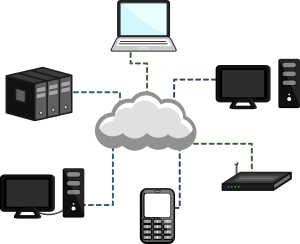Switch to SaaS-Its Simply Better
Software as a service (SaaS) is commonly referred to as “on-demand software”. It is a software delivery design in which software and related data are centrally hosted on the cloud. SaaS is generally accessed by users using a client through a web browser. Software as a Service is a surfacing system of delivering software applications to customers through the Internet. SaaS or On Demand software can be executed to reduce the ongoing costs that conventional applications entail.
Why is it so important to switch to SaaS? Because of the numerous benefits which cannot be ignored. Some of them are: 
Cheaper pricing entry:
Unlike conventional software which is traditionally sold as a long-lasting license with an up-front pricing and an optional ongoing support fee, SaaS suppliers normally charge applications using a subscription fee, commonly stated as a monthly or an annual fee. Accordingly, the preliminary setup cost for SaaS is normally lower than the corresponding enterprise software. SaaS merchants on average price their applications based on some usage factors, such as the number of users using the application. Nonetheless, because in a SaaS environment users data resides with the SaaS merchant, prospects to charge per transaction, incident, or other unit of value widely exists.
Global availability:
The equipment subsists to make on-premise software accessible outside the premises as well and not just accessibility but also functionality that are obtainable from anywhere on the internet natively. It is global at the core but flexible to meet local requirements. SaaS applications are available from any computer or any device anytime, anywhere. This is because; most users know how to find what they need on the Internet. SaaS application tends to have high adoption rates, with a lower learning curvature. Improved access to data from any networked device makes it easier to manage privileges, monitor data use. It also guarantees that everyone can access the same information at the same time from anywhere.
Multi -resident competence:
SaaS equipment is a multi-tenant architecture. This means that the cost of all software, infrastructure and expertise is shared by a large number of regulars. This improves the implementation speed and cost effectiveness of the application dramatically. SaaS applications are developing at a rapid rate because developers are focused on what’s next rather than on maintaining numerous versions of old code.
Easy Upgrades:
Since the SaaS source manages all updates and upgrades, there are zero possibilities of hitch for the customers to download or install. The SaaS provider also manages availability, so there’s no need for customers to add hardware, software, or bandwidth as the user pedestal grows.
Enlarged convenience and Productivity:
Web based applications facilitate users to save information on the Internet, hence making it easily available from anywhere. The business knowledge is made accessible to all employees thereby increasing combined productivity. Physically unconnected teams function better with better information accessibility. The other aspect is the decline in data center hassles incurred by software consumers in the conventional client/server model. This leaves data center workforce to focus on improving the day-to-day technical operations of the firm instead of being called upon to troubleshoot mediating party.
Flawless Integration:
SaaS merchants who have the right multitenant architectures can range indefinitely to meet client demand. Many SaaS suppliers also offer customization competence to meet explicit needs. The popularity of SaaS is steadily increasing because it simplifies deployment and reduces customer acquisition costs. With SaaS, developers can hold up many regulars with a single version of a product. This process is known as multitenancy. This enables companies to scale as fast and as much as needed without replacing the costly infrastructure or adding extra staff. Because of the way SaaS is designed, these customizations are exclusive to each company or user and are always preserved through upgrades. That means SaaS providers can get upgrades more often, with low customer threat and much lower implementation cost. Customization is simple with point-and-click simplicity; making the old fashioned update ritual of ‘waiting’ practically non-existent.
Enhanced Security:
Software as a Service providers are in the business of providing continuous reliable services. Sellers recognize that data must be backed up consistently, and information security is of extreme precedence. Competent resources, network redundancies, stand-by power, up-to-date security and intrusion detection are compulsory infrastructure required to provide an enterprise class service. This is the kind of security that the SaaS provides its users.
Data Center Talk updates its resources everyday. Visit us to know of the latest technology and standards from the data center world.
Please leave your views and comments on DCT Forum.
